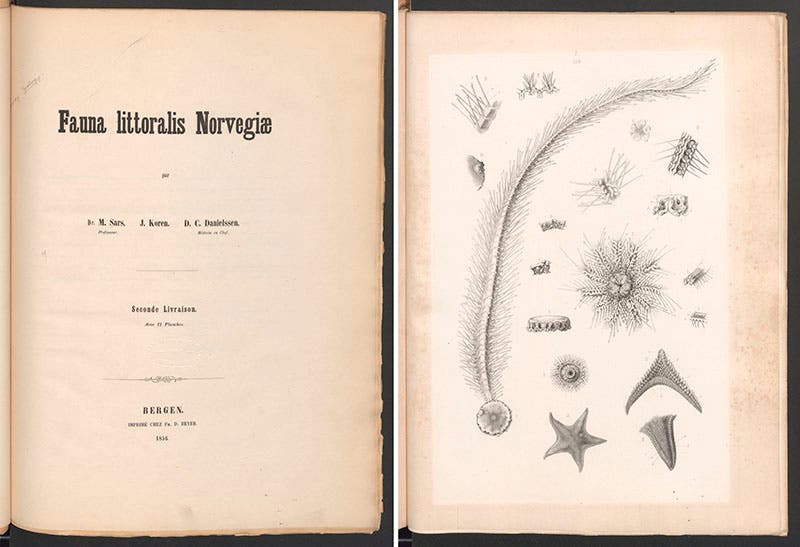Scientist of the Day - Michael Sars
Michael Sars, a Norwegian marine biologist, was born Aug. 30, 1805. Sars was the first deep-sea biologist of Norway, in the century that discovered deep-sea organisms. He first made a name for himself by realizing that many marine organisms, formerly thought to be separate species, are actually the larval stages of known animals, such as jellyfish, starfish, and mollusks (Charles Darwin had made a small contribution to this field when he discovered the free-swimming larvae of a sea mat named Flustra in 1827; it formed the basis for his first scientific presentation). In 1856, Sars published Fauna littoralis norvegiae, in two volumes, which illustrated many of the invertebrate organisms found off the shores of Norway (third and fourth images).
Subsequently, Sars became interested in testing the "azoic hypothesis" of Edward Forbes, who claimed that there were no living organisms in the sea below about 500 feet. Sars and his son, using a dredge, hauled up the first known living crinoids (formerly thought to be long extinct) from a depth of about 1800 feet, and he found many other living creatures in Norwegian fiords at even greater depths.
We have a copy of his Memoires pour servir a la connaissance des crinoides vivants (1868), which illustrates some of the living crinoids. Consequently, Sars became an advocate for international deep-sea dredging expeditions, leading to the famous Challenger expedition in the 1870s, which Sars unfortunately did not live to see or participate in.
Nearly four years ago, we featured Johan Hjort in this space. Hjort was a later Norwegian biologist who led a famous oceanographic expedition into the North Atlantic in 1910, sponsored by John Murray. The vessel for that expedition was the Michael Sars, named in honor of our subject for today.
Hjort's and Murray’s book on his 1910 oceanographic expedition, The Depths of the Ocean (1912), has photographs of: Michael Sars the marine zoologist (second image) and Michael Sars the oceanographic vessel (seventh image). There is also a fine wood engraving of Rhizocrinus lofotensis, the "living fossil" crinoid that Sars plucked from a fjord floor (first image).
The original ship Michael Sars is long gone, but as soon after it was scuttled, another was christened. The current Michael Sars is a Finnish oceanographic training vessel launched in 1979, and currently stationed in the port of Mariehamn at the mouth of the Gulf of Bothnia in the Baltic Sea (eighth image). Michael Sars apparently has staying power. Dr. William B. Ashworth, Jr., Consultant for the History of Science, Linda Hall Library and Associate Professor, Department of History, University of Missouri-Kansas City. Comments or corrections are welcome; please direct to ashworthw@umkc.edu.











